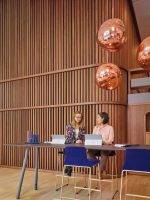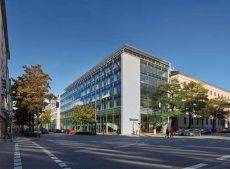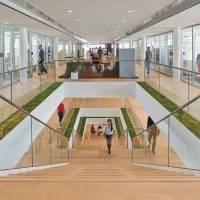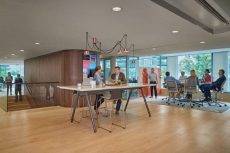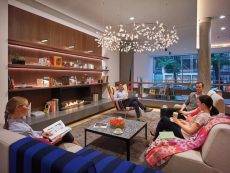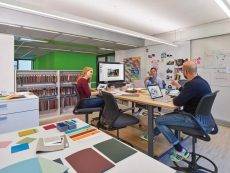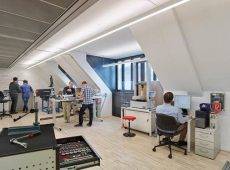November 21, 2017
The missing LINC between the office and the future of work
There is a theory that if you want to know how the economy is doing, you ask a taxi driver. The basis for this idea is that they are the first to know when money is getting tight, because people make more use of buses and tubes. In a similar way, one of the best ways of gauging workplace trends is to ask an office furniture company. They’ve always functioned in a fiercely competitive market, but are also the first to notice an economic downturn or a shift in the structure of their markets.
In recent years, this latter point has become of growing interest to the most progressive firms in the sector, who are responding not only with new products – the easy bit in some ways – but in asking existential questions about the nature of work, workplaces and their own place as businesses in a new order.
I recently visited the new Steelcase Learning + Innovation Centre (LINC) in Munich to witness how this process is playing out for the world’s largest manufacturer of office furniture. The firm recently celebrated its 100th anniversary and it seems pretty obvious that it intends to be around in another 100 so needs to cement a place in the new world of work.
Steelcase is an interesting firm to consider in this regard. Although it has a long history of designing groundbreaking products and developing the language we use to describe the workplace, and still plays on its associations with Frank Lloyd Wright, in many ways it lacks the design chops of its closest rival Herman Miller.
While Herman Miller is associated with the numerous mid twentieth century modernist classics that offer an instant shorthand for timeless cool, Steelcase has always been perceived as a colder corporate beast. If Herman Miller is Apple, Steelcase is Microsoft. This is an interesting and timely comparison in that Steelcase have recently announced a partnership with Microsoft that is in itself a signifier for the overlap of the digital and physical workspace.
The roots of LINC Munich have germinated from an old chestnut. Namely, that an office furniture showroom shouldn’t just offer a trawl through a firm’s products, but embody ideas about the workplace that can be discussed with clients. It’s not a brochure, but a story.
Firstly, it’s essential that it is home to the firm’s staff. Around 230 people from across the world have been brought together to work in the 14,400 square metre space.
“Creative work and innovation happens when trust is built. So, we designed a place where people could come together from all over Europe to build relationships, learn, fail and grow together,” said Jim Keane, president and CEO of Steelcase. “We believe this is central to innovation, but it’s not just for us — it’s for our customers, too. It gives them a place to experience real work as it’s happening and to see how space can support and accelerate business results.”
The space is designed around the now familiar concept of creating different types of space in which to work depending on an individual’s needs and preferences. This idea is an attempt to resolve the key paradox of modern working life, which is that while technology allows us to work anywhere, most of the best work we do – having ideas, solving problems, exchanging certain types of knowledge – happens while we’re with other people. And, of course, people like company.
So, features include a centrally located WorkCafé with a coffee bar and barista, an open plan space for the executive team and a range of quiet work areas, meeting and presentation spaces. It is impressively well kitted out from a technological point of view, Cloud based, WiFi enabled and with room booking systems, video conferencing and interactive boards and tables throughout. There is also an education and learning space, ostensibly designed to help clients explore ideas about how they work and how they might change them.
Underlying all of this are a couple of interesting ideas that tell us what Steelcase is driving at with its approach and what this tells us about what is happening in its market.
The first is the aesthetic direction of office design. People are right to talk about the effect of coworking on the way we occupy space and its effect on the property market, but rather less so far has been said about the design idioms of coworking spaces and their crossover into mainstream design (Neil Usher is a notable exception in this typically acidic take on the subject). In the case of Steelcase, this has involved not only the development of new products but the acquisition of businesses that allow them to offer a wider range to clients.
This is a direct response to the changing expectations people have of work. If they want their workplaces to look like artisan coffee shops, with bare bricks, exposed pipes and dangling lights, then that is all part of a quest for something human and authentic. Even if sometimes a cynic might call it faux-authentic. Fauxthentic.
As James Ludwig, Steelcase’s VP of Global Design told me in conversation: “There’s been a massive growth in the number of design savvy people in the general population. More and more people can crack the design code. What they want to see is the hand of the maker. Driving partnerships with the makers to create a platform that is rich in diversity for customers. No-one is immune from the disruptive pressure and so the disruptor is becoming the many.”
The second thing is that the LINC embodies the intersection of physical, cultural and digital workplaces. These are no longer siloed in quite the way they were and the best office furniture companies know it, even though some workplace professions seem to be struggling with the idea. There’s a reason why a growing number of HR professionals are taking decisions about the physical office nowadays.
It would be easy to see this as evidence of an evolving approach to design that is being pursued by Steelcase and others like them. This is the basis for the usual nonsense about the office of the future. The truth is something rather different. What we are witnessing is not the development of new ideas and new roles and new characteristics as part of something established and familiar, but something more fundamental.
It is speciation.
https://soundcloud.com/steelcase/behind-the-new-learning-innovation-center-with-steelcase-ceo-jim-keane





